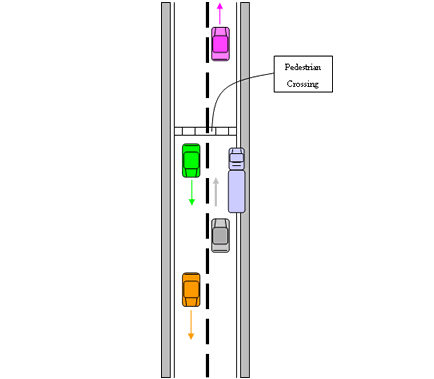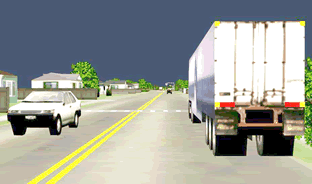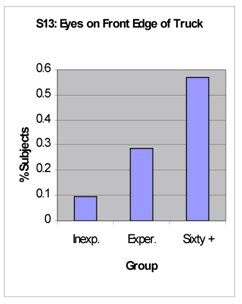Truck Parked in Front of Crosswalk
Novice drivers are much less likely to predict risks in scenarios where those risks might be hidden by vegetation, vehicles or the built-in environment. For example, as shown in Figure 1, a truck is parked immediately behind a crosswalk as the driver's car moves towards the cross walk. The truck obscures the driver's view of any pedestrians moving in front of the truck from the right, onto the crosswalk. The green car, to a lesser extent, obscures the driver's view of any pedestrians moving onto the crosswalk from the left. If the driver does not pay careful attention, a fatal crash could take place. In this case, a driver that is predicting the risk should look to the right as he or she passes in front of the truck. Note that we do not have a pedestrian actually emerge from behind the truck in this scenario or any other scenarios. We do put pedestrians on the crosswalk.
Figure 1. Plan View - Truck Parked in Front of Crosswalk.

Figure 2. Perspective View - Truck Parked in Front of Crosswalk.
Simulation - Truck parked in front of crosswalk
A clip of the simulation is available on our web site: http://www.ecs.umass.edu/hpl/. Follow the series of links below to reach the clip on the homepage:1) Our Research
2) Young Drivers (Link Foundation)
3) Link to Safe and Unsafe Driving Behavior
4) Truck Parked in Front of Sidewalk
Dependent Variables
We have used four dependent variables here: distance to the left of the truck when the driver moves over the crosswalk, velocity across the crosswalk, eye movements to the right as the driver passes in front of the truck, and head movements to the right as the driver passes in front of the truck. Head movements and eye movements are important because these differences are rather striking (Figure 3). One could simply use a video camera in the back seat trained on the driver's head and the view through the windshield if head tracking equipment was not available.
Results
We typically find that older drivers (60+) are five to six times more likely to look to the right for a potential pedestrian than are novice drivers, those with 6 months or less of driving experience (Figure 3). Experienced drivers included those between the ages of 18 and 30.

Figure 3. Percent of subjects with eyes on the front edge of the truck.


